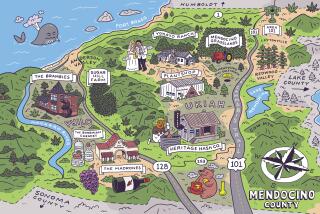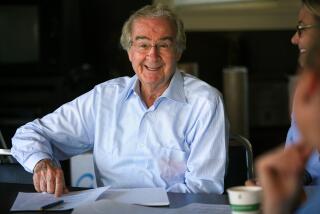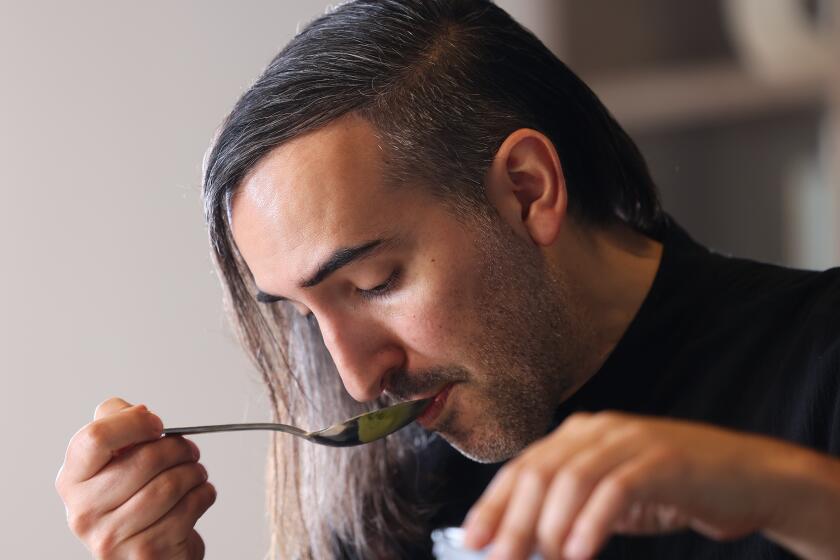The Ambassador from the State of Wine : With the publication of a controversial book, 85-year-old Robert Mondavi keeps things fermenting.
OAKVILLE, Calif. — Robert Mondavi can’t find a bottle of wine. Sure, there’s a table in his small office topped with a forest of bottles from around the world; then there’s the woodpile of various vintages casually stacked next to his desk. There’s even a magnum with Mondavi’s face hand-painted in gold lying on its side.
But Mondavi is looking for a bottle of his 1997 Cabernet, which represents the platonic ideal of wine that he has been trying to make for most of his life--a pursuit that, he admits, got him kicked out of the family business, broke up his first marriage and caused him to ignore and scold his sons; a Grail that has dominated his life as the dominant figure in the American world of wine.
The wine exists, the ever-optimistic Mondavi assures me. “It’s the best Cabernet I’ve ever tasted,” he says (as he says everything) enthusiastically.
He buzzes an assistant to find some. She buzzes back: There isn’t any at Mondavi’s winery in Napa Valley. A bottle will have to be procured from some outpost of the multinational Robert Mondavi wine empire.
What about that bottle on his desk? a visitor asks. Mondavi peers at a green bottle, no label, just a patch of tape with some handwriting that might as well be Sanskrit: CS4R4002-&*A.
Mondavi pours out the garnet liquid, just a hint of unsteadiness in his 85-year-old hands. Then, as he has so many times before, he picks up his glass: swirls, sniffs, sips. Eureka.
“Even though it’s big, it’s inviting,” the master pronounces. “It’s got that velvety feel on your mouth. It’s got that balanced, gentle fruit in the bouquet; it hugs the tongue with gentleness. It will harmonize with almost anything you eat.”
Mondavi isn’t lying. He has been sticking his large nose into wine glasses for far more than half a century. Although he is rarely ranked as one of the oenological greats, no one would dispute his place as a great salesman of the good life, as Napa’s most ambitious ambassador to the world. How Mondavi helped transform a sleepy farming valley called Napa into one of the great wine and food capitals on the planet is the subject of his recently published memoir, “Harvests of Joy: My Passion for Excellence--How the Good Life Became Great Business,” written with Paul Chutkow (Harcourt Brace).
Critics have not exactly been falling over one another to suggest that Mondavi start a second career as a writer.
“A strange combination of self-help volume and company press release,” former Wine Spectator editor Ted Loos called it in the New York Times Book Review.
“If ‘Harvest of Joy’ were a wine,” wrote Jay McInerney in the New Yorker, “we would have to say that it was a little disjointed, lacked complexity and had too much residual sugar. But then it’s entirely fitting that Mondavi’s most eloquent message still comes in a bottle.”
Mondavi was born in 1913 in Minnesota. His parents, Rose and Cesare Mondavi, had arrived in the U.S. as penniless, semiliterate immigrants from Italy. At school, young Mondavi was called a wop and a dago. At home, his mother added a shot of homemade wine to his coffee or a dollop of the stuff to his water at dinner and introduced him to the joys of olive oil, Italian cheese and honest cooking.
His father owned a saloon, and when the dark night of Prohibition descended upon the nation in 1919, Cesare Mondavi was deputized by the local Italian community to head west in search of grapes they could use to make the legal 200 gallons a year of wine for home consumption. Two years later, Mondavi moved the family to California and settled in Lodi, south of Sacramento.
Bobby Mondavi, as he was then known, went to Stanford and was planning on a career in law or finance when his father persuaded him to go into the family grape business instead, and in 1936 Mondavi headed up to Napa Valley to learn the bulk wine business. “Tank car wine,” they called it.
In 1943, Mondavi talked his father into buying the Charles Krug Winery, the oldest working winery in Napa, founded in 1861. The elder Mondavi insisted on one condition: that Robert run the business with his brother Peter, who is a year younger.
“Peter was quiet, gentle and self-effacing, a family man who loved to fish and adored spending time with his wife and children,” Mondavi writes.
None of this could be said of Robert Mondavi, a consummate road warrior who would leave home for weeks at a time to peddle the family’s wines to largely indifferent restaurants and retailers across the country.
His travels took Mondavi to Europe for the first time in 1962. He had been in the wine business for two decades, but what he saw there was a revelation: Wine wasn’t treated as a commodity warehoused in huge tanks but as a precious thing of art, lovingly aged in small oak barrels.
A lunch at the three-star La Pyramide outside Lyon tipped Mondavi into obsession. He vowed to create a wine to match anything he tasted on his trip.
At the time there were 20 wineries in Napa, most making feeble, amateurish stuff by today’s standards, and no restaurants to speak of--not to mention the fact that, as Mondavi puts it in his book, the American public thought that Velveeta was cheese and Wonder Bread something you could eat.
Meanwhile, there were tensions in the Mondavi family. At a 1965 gathering of the clan, Peter accused Robert of spending too much on travel and promotion, of squandering money on luxuries like a mink coat he had brought a few years earlier for his wife to wear to a White House dinner. Robert wound up slugging his brother.
“I smacked him, hard,” he writes. “Twice.”
At the age of 52, Mondavi was out of the family business. His mother begged him not to compete with Krug by starting his own winery.
“Bobby,” she pleaded. “Don’t do this.”
He did. In 1966, Mondavi broke ground on his namesake winery, a low-slung mission-style arch and campanile that has since become the famous corporate logo. Helped by local legends like Russian emigre winemaker Andre Tchelistcheff of Beaulieu Vineyard, Mondavi poured his passion into the venture and invested heavily in the latest technology, replacing the traditional wood fermenting vats with shiny stainless steel tanks and pioneering vacuum bottling. Mold and bacteria spoilage could be vanquished by New World science and technology.
The New World trumped the Old in 1976 at a now-famous blind tasting in Paris where American wines beat out some top French wines. Mondavi’s wines were not among the victors, but two of the winners had been made by Mondavi alumni, Mike Grgich and Warren Winiarski. The latter’s 1973 Stag’s Leap Wine Cellars Cabernet Sauvignon was the hit of the event.
That same year, Mondavi’s long-running feud with his brother over the ownership of Krug went to court in a nasty battle that ended with Robert Mondavi pocketing a half million dollars in damages and 20% of the company.
In 1979 Mondavi snapped up what would become his Woodbridge Winery in Lodi, which now produces an ocean of wine--around six million cases a year--and most of the company’s profits.
In 1993 he took the company public, selling shares at $13.50 each. Today shares of the Robert Mondavi Corp. trade for around $36, although they hit almost $52 earlier in the year.
The corporation now includes the Oakville winery; a partnership with the famed Baron Rothschild that makes a $100-a-bottle Bordeaux blend across the highway at Opus One; various other California wineries and ventures in France, Italy and Chile; and a spinoff label, La Famiglia di Robert Mondavi, that produces about 20,000 cases a year of Italian varietals.
“This,” Mondavi says, shaking his head in his office at the winery, “has gone way beyond what I ever thought.”
*
On a beautiful sunny fall day, Mondavi is sitting at a table in the grass courtyard of his winery, grapevines twisting in the distance toward the Mayacamas Mountains. Mondavi is a short man whose large oval head has a halo of steel gray hair, most of it in his eyebrows; his face has few wrinkles, and only hearing aides suggest any loss to time’s ravages. In front of him is a line of shareholders clutching copies of his new book, waiting for handshakes, signatures and pictures.
“In eight weeks,” he tells one friend who comes by, “I’ve been home for eight days.”
It’s the annual shareholders’ meeting: 850 people have turned out to hear Michael Mondavi, the company CEO and eldest son of the founder, report on how business is going. Revenue is $325 million a year, production close to 7 million cases--with a bottle sliding off the Woodbridge line every eight seconds. In 2001, he announces, Mondavi will open a wine pavilion at Disneyland. Business is good but it could be better. Only 11% of the U.S. population drinks 88% of its wine; three of four people say they like it but rarely touch the stuff. A vast market is waiting to be developed.
Five years ago the 80-year-old Mondavi turned the running of the business over to his son Michael, one of the three original paid employees at the company. Michael Mondavi has a businessman’s mien, with a booming voice and a hairline threatening to follow his father’s. His younger brother, Tim Mondavi, runs the vineyards and makes the wine. With thick blond hair and a bushy beard, he looks more like a farmer than his father ever did.
Tan and talkative as he signs books in the sun, the elder Mondavi hardly looks like the type who once woke a nephew staying at his house by pounding his fists into the walls and repeating over and over: “Only the strong survive.” But Mondavi is the first to admit that he’s spent most of his life in the monomaniacal grip of the grape.
“Bobby,” his sister Helen told him more than once, “we know you’re in the wine business. Can’t you talk about anything else?”
Mondavi has been known as a narrow perfectionist. He would pick apart the imperfections of the dinner his wife had just brought to the table, upbraid his sons in public for some failing. He made it into his 60s without showing the slightest interest in art, music or literature. He doesn’t read books; his second wife, Margrit Biever, skims the newspaper for him. He has no hobbies. Everything was always the business.
“Only later, much later,” Mondavi writes, “did I come to see how my tunnel vision, my steamrolling personality, and my total commitment to wine, wine, wine ended up inflicting terrible pain on [first wife] Marge, the children, and some of the people working closest to me.”
Today Mondavi might be retired, but he’s hardly retiring. He recently spent two weeks on the road hawking his book, then jetted over to Europe for several weeks, then went on to Hawaii. Most mornings he swims 20 minutes in the pool that fills the living room in his house perched in the hills above Yountville; then he drives himself down to the winery in his ’92 Cadillac. When he’s in town, it’s not uncommon to find him in the office by 7:30 a.m. He downs a glass or two of wine a day with lunch, then shares a bottle at night with his wife.
“It keeps you alive,” he says.
“Age does not matter,” says a pillow in Mondavi’s office, “unless you are wine.”
Mondavi’s once-high voice is hoarse, as if all the years of talking about wine and its import to life have frayed his vocal cords. As Mondavi strides briskly toward his 90s, there is still more to talk about: for instance, his latest brainchild, the American Center for Wine, Food & the Arts, which is scheduled to break ground on 13 acres this summer on the banks of the Napa River in downtown Napa. The $40-million complex is another Mondavi original, with plans for concerts and art exhibitions, cooking and art classes, flower and vegetable gardens, a restaurant and wine tasting. But to describe the venture in merely secular terms doesn’t do justice to Mondavi’s all-encompassing vision.
“This will be a center that will last for 500 years or more,” he says. “People will be taught how to enjoy their life more through food, wine and the arts. It’s education. What’s wrong with teaching people how to live better? I want to help revitalize the city of Napa.”
The city of Napa (population 70,000) is what people usually drive through as fast as they can to get to the more bucolic surroundings further north. Napa Valley might attract 5 million visitors a year, plausibly claim the best restaurant in the country (the French Laundry) and host celebrity wine auctions for charity, but the city of Napa gets gang shootings (six were wounded in a recent one), claims the same fast-food franchises as every other soul-sucking stretch of strip malldom in the country and manages to draw any attention to itself only when the Napa River swallows the downtown during a flood.
To Mondavi’s critics, the center will simply be another tourist magnet luring Silicon Valley millionaires and San Francisco yuppies up to Napa’s already clogged roads while doing nothing for the city’s blue-collar residents, who are about as likely to show up at an Alice Waters cooking class as they are to have swimming pools in their living rooms.
“The town is split over the whole Mondavi thing,” says Harry Martin, publisher of the Napa Sentinel, a city council member and 30-year resident of the town. “He’s saying, ‘I want to change the face of Napa,’ but he doesn’t even live in Napa.”
But Mondavi sees the center not as an island of affluence in a working-class town but as a beacon that will show the masses that the good life is not just the province of the well-heeled.
“We’re going to teach children to get away from junk food, to grow vegetables and have good healthy food,” he says. “We made wine elitist. We scared people. We made a great mistake. People don’t know how to drink; they need education. Wine is part of living well. Our country isn’t aware.”
His detractors, Mondavi says, just aren’t thinking big enough.
“All my life people have been telling me that you can’t do that,” he says. “They said I was completely crazy. Now our wines belong in the company of the greatest wines in the world. We want to improve our living in exactly the same way. The city and county of Napa will be known the world over.”
More to Read
Eat your way across L.A.
Get our weekly Tasting Notes newsletter for reviews, news and more.
You may occasionally receive promotional content from the Los Angeles Times.










